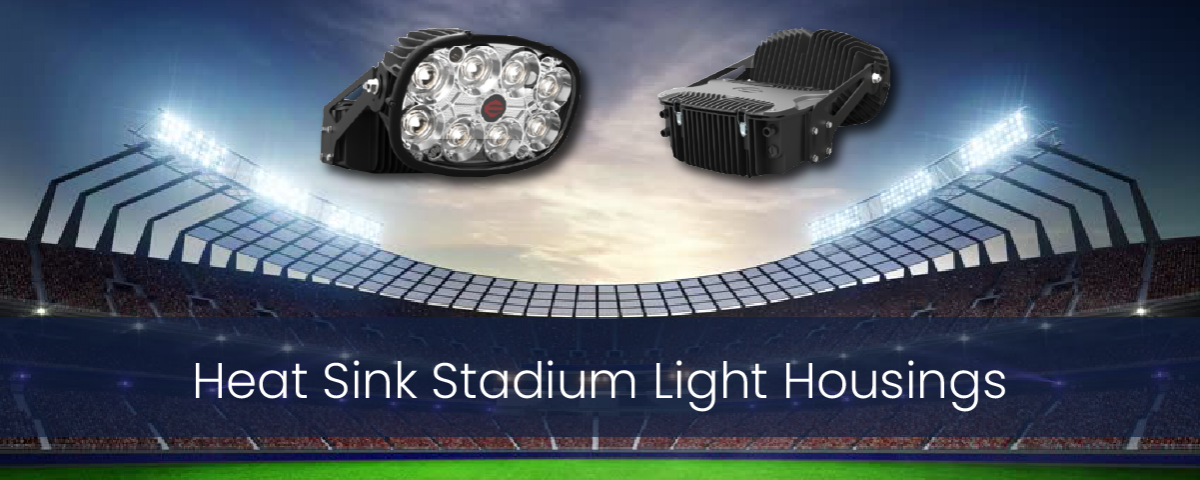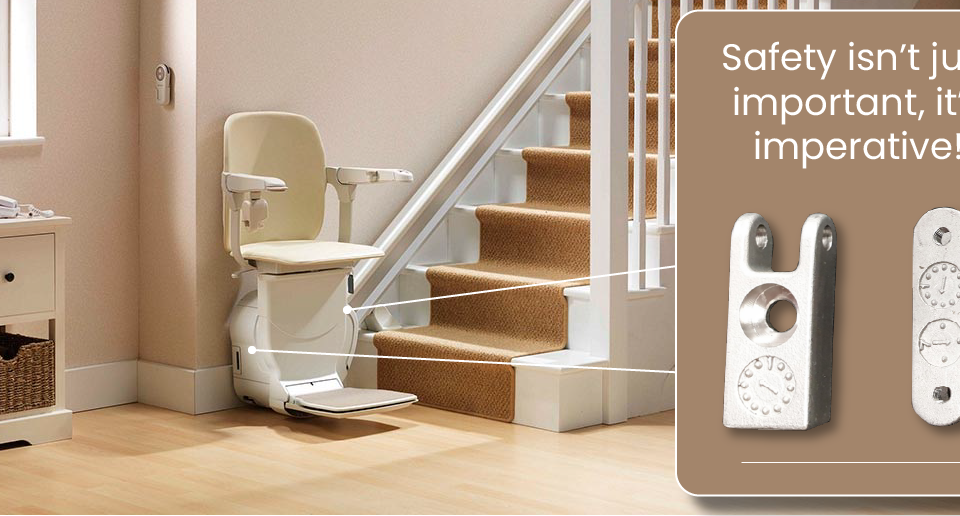Heat Sink Stadium Light Housing Application Case Study

Industry: Commerical Lighting (professional stadium lighting)
Company Type: Lighting OEM
Light fixture OEMs are challenged daily to compact a large number of LEDs in a tight package. These LEDs emit a lot of heat which must be dissipated away to keep the warranties and shelf life on the fixture. Some of the most demanding light intensity demands are on stadium lights. Customers expect entertainment, as well as visual quality and stadium lighting, is expected to deliver on these expectations.
One of the world’s dominant lighting OEMs had this demanding application in the concept phase.
In response, our engineering and quality teams collaborated with this long-time customer to solve a design challenge the customer was having with a complex die-cast. In fact, one of the guiding principles as an organization is to collaborate. We can think of nothing more rewarding than collaborating with our customers, either.
Challenges with the part were multi-fold, starting with the heat sink ribs for heat dissipation:
1) Complex rib geometry
2) Thick and deep rib sizes which dictate the amount of heat dissipated
3) Rib proximities to each other
4) Weight of the part at 12.31 kgs!
5) Chromate coating as well as powder coating
Die casting of this size can only be made in presses above 1600 Ton. Only 15% of the total amount of presses are larger than 1600 Ton so MES was limited to about 4 suppliers which have this press size and capacity available. Tooling for these types of parts can cost north of $350,000 in North America and can have lead times north of 16 weeks. The customer didn’t have enough tooling budget and was constrained on tooling lead-time to be around 8-10 weeks for its marketing team.
MES has pre-approved tool shops in China and Taiwan which can make tooling to its tool riders and global standards.
These types of demanding engineering applications require robust design reviews and collaboration between OEM customers, MES application engineers as well as manufacturing engineering. Collaboration lets us take our engineering and manufacturing expertise and pair it with our customer’s expertise in the functional requirements of the part. Together, we end up with the best part, manufactured in the easiest possible way, in the most cost-effective manner.
“We could have taken the specs from the customer and just made the part. Bringing them in early on kept us from cutting out some important functional requirements. And it kept them from putting extra costs into things that really weren’t necessary. There was a lot of back-and-forth on this part since it was large with complex geometry. By investing time upfront, we were able to manufacturer a high-quality part, meet functional specs, and save a few dollars per piece on a high-volume run.” – Mark Nigro, MES Engineer
Asking Questions
With all the problem-solving that goes on in a typical day, it can be pretty tempting to jump straight to the fix. But, if you only have a cursory understanding of a challenge, you’re shortchanging yourself and your customer. One of the many reasons we involve customers in our problem-solving sessions is because the customer knows things that we simply cannot know. Our initial task, then, is to ask questions – good ones. Their task is to respond by providing as much detail as humanly possible.
So, when our customer, a leading indoor/outdoor lighting manufacturer, came to us with a die casting design challenge, we started by asking questions like this:
- What is the fit, form, and function of the part?
- What environment will this part be used in?
- Why do you think this problem is happening?
- What factors have contributed to the problem?
- Why does this problem need addressed right now?
- What have you already considered or done to solve the problem, and what were the results?
- If the problem doesn’t get resolved, what will the impact be on your business and your end user?
- Once the problem is resolved, what’s your ideal outcome or desired end result?
Through our Q&A, we learned that the customer had not one but two problems with a die casting of one of their light assemblies.
Challenges
Our customer wanted to add more features to the casting. Okay, not a problem, per se. That was until we understood that the casting geometry needed to be optimized. Optimization would not only make the part easily and accurately castable but also ensure that it met functional requirements.
The second problem revealed through collaborative Q&A was this: How do we properly powder coat the new design to finish it because the new design has deep fins that act as a required heat sink to keep the component cool while in use. These deep fins were inherently difficult to evenly powder coat top-to-bottom within the minimum and maximum allowable powder coat thickness specifications.
Collecting Data
While gaining insight and perspective is a key step in collaborative problem-solving, it’s far from the only step. Collecting data is absolutely imperative because it provides the evidence needed to find and support the very best solution.
Data can and often is figures, metrics, and statistics. It also can be observations, documented information, photos, and the like.
In the case of our lighting customer, MES engineering worked closely with them in a fact-finding methodology known as DFM or Design for Manufacturing. DFM is an end-to-end process that lets us manufacture parts to standard as quickly and cost-effectively as possible.
Together with our customers, our teams collected data through a variety of means, including conducting both a mold flow analysis and gating review.
Synthesizing Information
Once we had our customer insights and data collection in hand, the next step in our joint problem-solving process is making sense of what we know in order to develop one or more solutions to test and approve.
We began by asking ourselves this important question, “What goals or outcomes do we want from the ideal solution?”
Our goals for this project were:
- Maximize production
- Implement quality controls
- Design a part that could withstand both complex geometries and critical tolerances for thermal conductivity
- Produce a final product that had an even powder-coated finish from top-to-bottom
Determining the Solution
With our goals set, we revisited our findings and data, looking for the root causes of the painting challenge. This led us to consider the powder coat specification’s minimum and maximum thicknesses. We surmised that since powder coat paint is applied by a spray gun like spray paint, it would be virtually impossible for the paint to reach all the way to the bottom of the deep cooling fins without applying too much paint at the top of the fins. MES’s highly skilled and experienced powder coat experts offered their feedback on maximum depth-to-width ratios for the cooling fins.
MES’s engineering team then found special paint nozzles that have the ability to penetrate deeply to the bottom of the casting’s fins. The combination of these nozzles with the correct air pressure meant that we’d found a way to accurately apply an even coat of paint throughout the fin, again, all within specification.
Meanwhile, MES engineers began conceptualizing a design that could withstand a robust casting process, and be manufactured correctly and within specification requirements. At the same time, our customer’s engineers offered their input to make sure that the final casting could meet stringent thermal testing targets, solid functional requirements, and desired aesthetics.
The end result was an MES casting that exceeded customer expectations. And that is the very best end result of all.
Collaborative Problem-Solving Works
To find the very best solution to a challenge, you have to problem-solve with your customer. Together, customers and suppliers can figure out what the problem is, why it happened, and, most importantly, what to do about it. Bottom line: If you want to solve problems, involve your customer.
Do you have the right problem-solving partner? Start problem-solving today with MES.
The MES Solution At-a-Glance
Industry: Lighting Equipment Manufacturing – Product Rework Die Casting
Company Type: Indoor/Outdoor Lighting Solutions OEM
Size/Rank: Industry Leader
Challenge: Our customer, a forward-thinking lighting manufacturer, needed a die casting design reconfigured and optimized to better absorb and dissipate heat to keep the fixture cool. In addition to making the tooling more complex, the additional features created a secondary challenge: ensuring that the paint coverage was of the highest quality and within specifications.
Solution: MES’s quality and engineering groups teamed up with the customer to ensure a part design that met stringent thermal testing targets, functional requirements, and aesthetics while also allowing for robust casting and repeatable powder coating processes.
Results: The collaborative and iterative process resulted in an optimized, in-spec die-cast design, production, and final part that far exceeded customer expectations.
Metrics:
3 teams working closely together to problem-solve castability and in-spec powder coating issues
2 challenges included how to add more features to the casting and still allow for the application of even layers of paint
1 the methodology that involved mold flow analysis, gating review, and part design
Services:
- Aluminum Cold-Chamber Die Casting
- Collaboration Strategies & Solutions
- Rework & Tooling Design
- Painting & Powder Coating
- Advanced Computer-Assisted Precision Engineering





